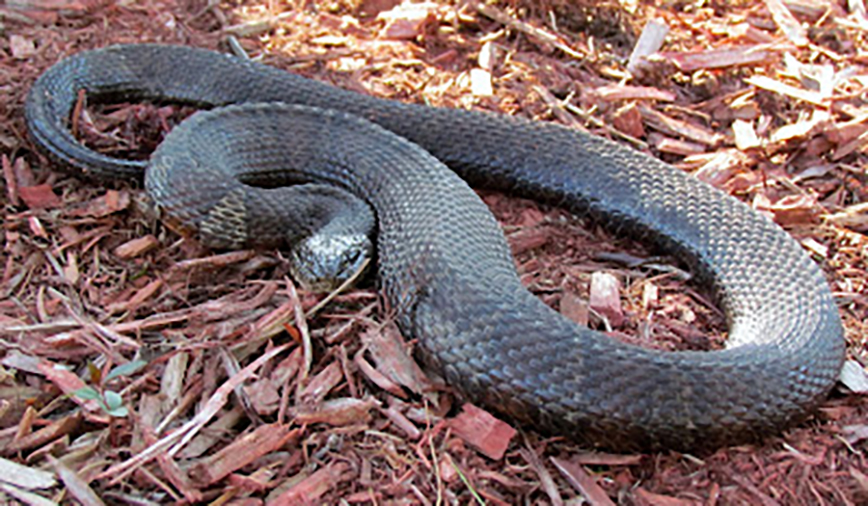Maybe you’ve heard, a snake caused quite a stir in the TriCities this past week.
Following a lead story on NBC-5 News that reported a Deadly Snake on the Loose in Geneva, I received no fewer than a dozen phone calls, text messages and emails expressing a variety of sentiments. They ranged, on the mild end, from “Really?” and “What??” to, on the coarser end, variations on the saying, “Holy crap!!!”
My reaction was more along the lines of “Oh boy!” followed a little while after by, “Hey, wait a minute…”
When Allison Rosati used the term “deadly,” my brain immediately went to thoughts of snake species with highly toxic venom like the Australian brown snake or taipan. Maybe even a cobra, I recall thinking, while also wondering what bizarre set of circumstances would have led to any of these animals surfacing in Geneva.
Imagine my surprise when the snake in question turned out to be a cottonmouth, Agkistrodon piscivorus. These large, dark, heavy-bodied snakes, while venomous, don’t come anywhere near the realm of “highly.” It’s true, without treatment, there is a chance you could die after being bitten by a cottonmouth—or any North American pit viper. And the pain from the bite may make you wish you were dead. But chances are good that, with prompt medical attention, you would survive.
The next question I had was how the heck would a cottonmouth make its way to this part of the state? The species’ natural range is way down at the very southern tip of Illinois.
I remember learning about and seeing these snakes several years ago during a wonderful workshop put on by the Illinois Natural History Survey. We were at the legendary Snake Road, which in reality is Forest Service Road 345 in the LaRue Pine Hills section of the Shawnee National Forest.
The herpetologist pointed to a map of Illinois–specifically, the counties south of Carbondale—as the area where cottonmouths occur. As his finger circled around this small region, a bluffy, swampy, unglaciated land that really seems like it’s a different state entirely, I realized I had been living a lie.
As I kid I spent a week or two of every summer on my mom’s family farm in Menard County, northwest of Springfield. Even then, go figure, I was prone to poking under rocks and peering under logs. I can clearly remember being warned about water moccasins by everyone from Grandma and Grandpa to the neighbors to the mailman because, bless their hearts, they didn’t want me to get bit and die.
More than once I came across large, dark snakes in the water, and each time I backed away carefully, then went around telling everyone who’d listen how I’d narrowly escaped death by snake bite.
Yet there was Scott Ballard, one of the state’s foremost herpetologists, saying that cottonmouths, a.k.a. water moccasins, a.k.a. A. piscivorus, are only present waaaay down south in Illinois.
That little lesson in snake ranges, geography and the hazards of using only common instead of scientific names resonates with me to this day.
Snakes in general have a p.r. problem, and heavy-bodied snakes that live near are almost universally despised. Part of the issue lies with how people apply the term “water moccasin.” Some folks use it in reference to venomous cottonmouths, while others apply it to any snake that lives near water.
In much the same way the game Telephone can change the meaning of a simple sentence, repeated tellings of a story involving a water moccasin—as in nonvenomous Nerodian—can quickly morph into tales of derring-do during a chance encounter with a cottonmouth.
Then there’s that word venom. People tend to associate it with “certain death,” even though that is often not the case. For certain kinds of snakes, venom is their only means of survival. It can be used defensively, yes, but its true purpose is to help the snake subdue its prey.
At any rate, noting the confusion that surrounds these terms, it becomes a little easier to see how random sightings of a fat, and most likely happy, snake in an area of unincorporated Geneva that has a pond nearby turns into “Deadly Snake on the Loose in Geneva.”
Could it be a cottonmouth, A. piscovorus? Given how mobile our society is these days, not to mention how easy it is to buy things, even venomous snakes, on the internet, we can never say never. I for one will anxiously await the outcome of the ongoing snake search.
In the meantime, I’m going to take full advantage of this rare moment when snakes are in the limelight. I’ll be doing everything I can to spread the word that snakes—even venomous ones—have important jobs to do. They control animals that tend to overpopulate. They capture weak or ill individuals, thus keeping wildlife populations fit and strong.
They can also help control the spread of disease. Have you ever heard that Europe’s Black Death could have been mitigated, if only the continent had had more rodent-eating snakes? Put in more recent terms, snakes may be one of our best allies in the fight against Lyme disease—a serious ailment spread by ticks that parasitize mice.
“More Snakes = Fewer Pests = Less Illness, details at 10.” Now there’s a lead story I’d love to see.
Pam Erickson Otto is the manager of nature programs and interpretive services at the Hickory Knolls Discovery Center, a facility of the St. Charles Park District. She can be reached at 630-513-4346 or potto@stcparks.org.
August 28, 2015
Water Snakes
A large, dark snake lies coiled near a body of water in St. Charles. Is it a venomous cottonmouth? Not in this case. The snake pictured is a northern water snake, Nerodia sipedon. The species is noted for being heavy bodied, as well as a tendency to darken with age. Closer inspection reveals a second water snake, a juvenile, coiled atop the larger adult.

